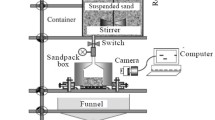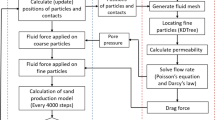Abstract
Water injection in aquifers to stabilize water level is a novel method to prevent shaft failure. However, with the progression of water injection, the flow rate of water injection decreases gradually. Through analysis, it is considered that the fine particles in sand migrate to form a dense structure, which hinders the increase of water flow. In order to investigate the migration mechanism of fine particles in the aquifer during water injection, experimental tests and numerical simulations were conducted in the present study. First, the physical experiment was designed, and it was shown that the water pressure difference between the two pressure gauges gradually decreased, while the water flow rate per hour slowly decreased. Furthermore, the permeability coefficient of sand near the outlet became smaller and smaller with the migration of fine particles, which indicated that the fine particles among sand grains migrated gradually from the water injection inlet to the outlet. Additionally, the water flow channels formed slowly. Then, the microscopic mechanism of fine particle migration was studied using particle flow code numerical simulation. During water injection, water pressure and porosity of sand decreased from the water injection inlet to the outlet, while the coordination number of particles increased on the whole. Contact force chain gradually strengthened near the outlet side during water injection. The trends of force chain distribution, the coordination number distributions and the evolution of porosity were consistent, which highlighted the process of fine particles migrating from the injection inlet to the outlet in the aquifer.















Similar content being viewed by others
References
Boutt DF, Cook BK, Williams JR (2011) A coupled fluid–solid model for problems in geomechanics: application to sand production. Int J Numer Anal Meth Geomech 35:997–1018
Cao Z, Wei L, Xie J (1995) Sediment-laden flow in open channels from two-phase flow viewpoint. J Hydraul Eng 121:725–735
Cellino M, Graf WH (1999) Sediment-laden flow in open-channels under noncapacity and capacity conditions. J Hydraul Eng 125:455–462
Chauchat J (2007) Contribution to two-phase flow modeling for sediment transport in estuarine and coastal zones. PhD thesis, University of Caen, France (in French)
Chauchat J, Guillou S (2008) On turbulence closures for two-phase sediment-laden flow models. J Geophys Res 113(C11):C11017
Coleman NL (1981) Velocity profiles with suspended sediment. J Hydraul Res 19(3):211–229
Cui GX (1998) Mechanism and prevention of shaft fracture in special stratum. Min Construct Technol 19(4):28–32 (in Chinese)
Drew DA, Passman SL (2006) Theory of multicomponent fluids, vol 135. Springer, Berlin
Elghobashi S (1994) On predicting particle-laden turbulent flows. Appl Sci Res 52:309–329
Elghobashi SE, Abou-Arab TW (1983) A two-equation turbulence model for two-phase flows. Phys Fluids 26:931–938
Gao J, Wang ZQ, Cheng JY, Zhang XJ (2009) Analysis of the additional stress induced by dewatering for the failure of shaft wall in the thick alluvium. Chin J Undergr Space Eng 5(5):873–877 (in Chinese)
Greimann BP, Holly FM Jr (2001) Two-phase flow analysis of concentration profiles. J Hydraul Eng 127:753–762
Greimann BP, Muste M, Holly FM Jr (1999) Two-phase formulation of suspended sediment transport. J Hydraul Res 37:479–500
Gu MH (1991) Discussion on the mechanism and treatment of shaft wall breaking. Coal Sci Technol 29(44–47):60 (in Chinese)
Hsu TJ, Jenkins JT, Liu PLF (2003) On two-phase sediment transport: dilute flow. J Geophys Res 108(C3):3057
Isehunwa S, Farotade A (2010) Sand failure mechanism and sanding parameters in Niger Delta oil reservoirs. Int J Eng Sci Technol 2:777–782
Jha SK, Bombardelli FA (2009) Two-phase modeling of turbulence in dilute sediment-laden, open-channel flows. Environ Fluid Mech 9:237
Jiang J, Law AWK, Cheng NS (2005) Two-phase analysis of vertical sediment-laden jets. J Eng Mech 131:308–318
Kim AS, Sharma MM, Fitzpatrick H (2011) A predictive model for sand production in poorly consolidated sands. In: Proceedings of the international petroleum technology conference, Bangkok, Thailand, vol 9, pp 15–17
Kobayashi N, Seo SN (1985) Fluid and sediment interaction over a plane bed. J Hydraul Eng 111:903–921
Levy T (1990) Fluid flow in a porous medium with unidirectional fissures. CR Acad Sci Ser II 310(6):658–690
Liu HY (2005) The study of developing mechanism and harnessing technology for shaft fracturing in thick alluvium. PhD thesis, Hehai University, Nanjin, 2005 (in Chinese)
Liu SQ, Jie YX, Xu YC (2017) Prevention of mine-shaft failure by aquifer replenishment. J Test Eval 45(3):889–903
Mariano I, Cantero S, Balachandar Gary Parker (2009) Direct numerical simulation of stratification effects in a sediment-laden turbulent channel flow. J Turbul 10:N27
McTigue DF (1981) Mixture theory for suspended sediment transport. J Hydraul Div 107:659–673
Ni XH, Xu YC, Wang TF (2007) Mechanism and prevention of shaft fracture in thick alluvium. China Coal Industry Publication House, Beijing (in Chinese)
Noguchi K, Nezu I (2009) Particle–turbulence interaction and local particle concentration in sediment-laden open-channel flows. J Hydro-environ Res 3:54–68
Nouri A, Vaziri H, Belhaj H (2003) A comprehensive approach to modeling sanding during oil production. In: SPE Latin American and Caribbean petroleum engineering conference. Society of Petroleum Engineers
Nouri A, Vaziri H, Belhaj H, Islam R (2006) Sand-production prediction: a new set of criteria for modeling based on largescale transient experiments and numerical investigation. SPE J 11:227–237
Nouri A, Kuru E, Vaziri H (2009) Elastoplastic modelling of sand production using fracture energy regularization method. J Can Petrol Technol 48:64–71
Papamichos E, Stavropoulou M (1998) An erosion–mechanical model for sand production rate prediction. Int J Rock Mech Min Sci Geomech Abstr 35:531–532
Ranjith PG, Perera MSA, Perera WKG (2013) Effective parameters for sand production in unconsolidated formations: an experimental study. J Petrol Sci Eng 105:34–42
Romm ES (1966) Flow characteristics of fractured rocks. Nedra, Moscow
Su J, Cheng H (2000) Theoretical analysis of additional force of wellbore in hydrophobic settlement. J Rock Mech Eng 19:310–313 (in Chinese)
Toorman EA (2008) Vertical mixing in the fully developed turbulent layer of sediment-laden open-channel flow. J Hydraul Eng 134:1225–1235
Vardoulakis I, Stavropoulou M, Papanastasiou P (1996) Hydromechanical aspects of the sand production problem. Transp Porous Media 22:225–244
Vaziri H, Barree B, Xiao Y, Palmer I, Kutas M (2002) What is the magic of water in producing sand? In: SPE annual technical conference and exhibition, San Antonio, TX, USA, vol 10, pp 2973–2985
Vaziri H, Nouri A, Hovem K, Wang X (2008) Computation of sand production in water injectors. SPE Prod Oper 23:518–524
Villaret C, Davies AG (1995) Modeling sediment-turbulent flow interactions. Appl Mech Rev 48:601–609
Wan RG, Wang J (2000) Modelling sand production within a continuum mechanics framework. In: Canadian international petroleum conference, Petroleum Society of Canada
Wang WC (1996) Strength analysis of shaft based on surface subsidence caused by thick alluvium draining. J China Univ Min Technol 25(3):54–58 (in Chinese)
Wang GQ, Ni JR (1991) The kinetic theory for dilute solid–liquid two-phase flow. Int J Multiph Flow 17:273–281
Wang Y, Jiang Q, Xu AZ, Zhang CK (2016) A vertical 2-dimensional CIP-DEM coupling numerical model for water-sand two phase flows. Sci Technol Eng 16:111–118 (in Chinese)
Willson SM, Moschovidis ZA, Cameron JR (2002) New model for predicting the rate of sand production. In: SPE/ISRM rock mechanics conference, Society of Petroleum Engineers
Xu YC, Li JH, Zhang Q, Wang X (2014a) Engineering parameters of water injection to control mine shaft damage at Jisan coal mine. J Liaoning Tech Univ (Nat Sci) 33(9):1153–1158 (in Chinese)
Xu YC, Li XD, Jie YX (2014b) Test on water-level stabilization and prevention of mine-shaft failure by means of groundwater injection. Geotech Test J 37(2):319–332
Xu YC, Du MZ, Luo YQ (2019) Using water injection to prevent shaft failure in the Jining no. 3 coal mine, China. Mine Water Environ 39(1):60–71
Zhou Z (1993) Mechanical erosive erosion at the bottom of thick loose coating and wellbore rupture in Huanghuai area. Coal Sci Technol 31:45–50 (in Chinese)
Acknowledgements
We gratefully acknowledge the financial support provided by the Project funded by China Postdoctoral Science Foundation (Grant No. 2019M660598), the China Coal Research Institute Science and Technology Innovation Fund (Grant No. 2019CX-II-13), the National Science and Technology Major Project of China (Grant No. 2016ZX05045001-004) and the China Scholarship Council (CSC No. 201608370083).
Author information
Authors and Affiliations
Corresponding author
Additional information
Publisher's Note
Springer Nature remains neutral with regard to jurisdictional claims in published maps and institutional affiliations.
Rights and permissions
About this article
Cite this article
Du, M., Gong, B., Xu, Y. et al. Migration mechanism of fine particles in aquifer during water injection. Nat Hazards 102, 1095–1116 (2020). https://doi.org/10.1007/s11069-020-03947-4
Received:
Accepted:
Published:
Issue Date:
DOI: https://doi.org/10.1007/s11069-020-03947-4




